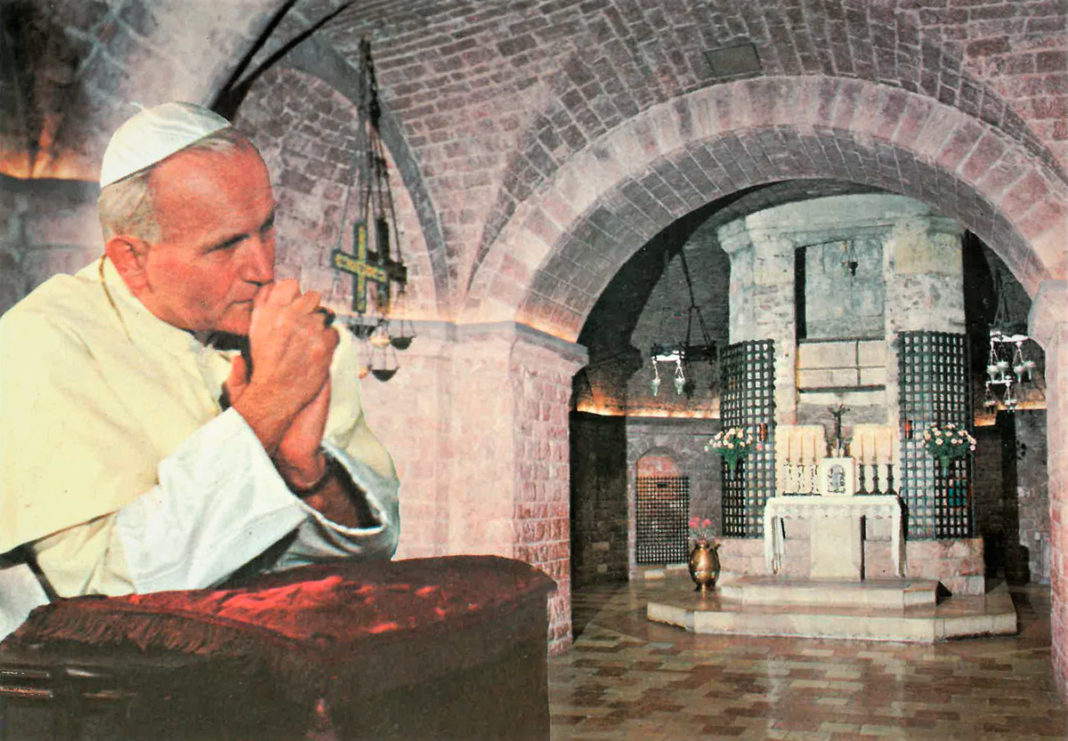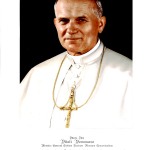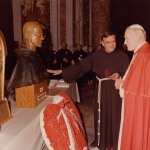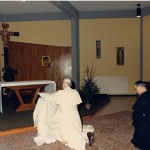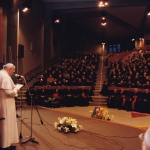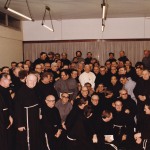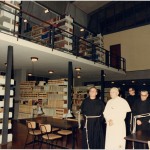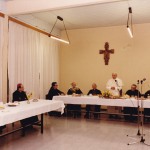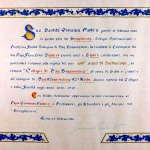May 18, 2020, marks the 100th birthday of St. John Paul II, the pope from Poland who changed the face of the Church and the world. It is a fitting occasion to show some of the connections he had with the Friars Minor Conventual.
Here is what he said himself: “I will tell you that, as Archbishop of Cracow, I lived near a very ancient Franciscan church, and from time to time I went there to pray, to make the “Via Crucis” and to visit the Chapel of Our Lady of Sorrows. Unforgettable moments for me!”
These words are found in the manuscript of a speech he gave on November 5, 1978, in Assisi, shortly after he had been elected Pope.
In those brief words, he reveals his deep feelings about that Franciscan place. How did his connection to it and his feelings for it come about? To answer that, one must go back in time, dig through the past, and come back with certain facts.
Karol WOJTYŁA (1920-2005) was involved with the Conventual Franciscans in Cracow as far back as 1938, in his early youth when he was a student. He made contact with them again while he was a laborer in the Solvay mine during the Second World War. At that time, he was attending our church, and on weekdays he went to the 5:30 a.m. Mass. He attended the Sunday Mass at noon, a Mass which featured magnificent sermons by Friar Bonawentura PODHORODECKI, who would later be martyred in the Nazi concentration camp in Auschwitz in 1941. After Karol WOJTYŁA was ordained a priest, he continued to stop by the Conventual Franciscan Basilica. When he became the Archbishop of Cracow, he resided in the bishop’s palace, right across the street from our church and friary. He would often be in the Basilica as early as 6:00 a.m. for Morning Prayer. It was his custom to sit in the last pew at the end of the church entrance. He would do an hour of meditation and recite the Office. He would often and willingly stop by the Chapel of Our Lady of Sorrows and he would visit the Chapel of the Lord’s Passion to pray the Stations of the Cross. He would come in at 11:00 p.m. on New Year’s Eve for personal Eucharistic adoration, then, celebrate the midnight Mass and give a homily. He was often invited to preside over liturgical celebrations and willingly participated in the meetings of various church groups. Once he even took a seat in the confessional to administer the sacrament of reconciliation. In his episcopal agenda, he recorded these moments with a very simple and familiar expression: “at the Franciscans’”.
However, his relations with the Conventuals were not confined to the friary in Cracow. Before he was elected Pope, while he was still the Archbishop of Cracow, he visited more than twenty communities of our friars in Poland and abroad. In addition, he visited some of our well-known Marian shrines in Poland: He went to Niepokalanów five times and visited Kalwaria Pacławska, Rychwałd six times. We should also mention his visits to Conventual sites in Italy, such as the Basilica of St. Francis in Assisi, the Sanctuary of the Eucharistic Miracle in Lanciano, the Church of the Immaculate Heart of Mary in Verona, the Abbey in Fossanova, the Basilica of the Twelve Holy Apostles in Rome (two visits) the Church of Santa Maria Immacolata a Via Laurentina in Rome’s EUR district, the old Seraphicum International College on Via San Teodoro in Rome, (where the Militia of the Immaculate was founded), and the Vatican College of Penitentiaries. In addition, he visited our Church of the Immaculate Conception of the Blessed Virgin Mary in Cologne, Germany. He also visited the well-known “Father Justin Rosary Hour” Radio Center in Buffalo, New York, USA, a Polish-language radio program founded for Polish immigrants. Finally he visited four of our pastoral centers in Montreal Canada.
When John Paul II was elected to the Chair of St. Peter in 1978, our then Minister General, Friar Vitale BOMMARCO, expressed his deep gratitude to the Pope for the “benevolence and paternal support” he had shown to our friars in Cracow.
John Paul II would often reminisce about his “unforgettable moments” in Cracow: “How dear to my heart this Franciscan church is, along with that image of Our Lady of Sorrows [Smętna Dobrodziejka]. I would often go there to entrust many situations to Mary’s goodness, especially concerning my ministry as a priest and later, as a bishop. How many graces, how much good counsel I gained from that place, a place that had been visited for five centuries by generations from Cracow and by many pilgrims from Poland and from all over the world. Today I thank God for all the gifts granted to me through the intercession of Mary venerated in the Image of Our Lady of Sorrows” (1998).
Perhaps his recollection of those hours of prayer and the time he spent at the Franciscan Basilica in Cracow, led him, at the beginning of his papacy, to choose one of our friars to preach the Lenten spiritual retreat for the Vatican Curia in 1979, namely, Friar Faustino OSSANNA, a well-known philosopher and theologian. John Paul II’s sermons, of course, made many references to Franciscan spirituality. During that spiritual retreat, he began to write his testament, where he included those words so dear to our long Franciscan tradition: “In life and in death [I am] Totus Tuus through Mary Immaculate” (Testament of John Paul II, 1980).
Continuing our study, let us take a look at the time of his Petrine ministry. During his pontificate, he visited a total of twenty-four Conventual places, including friaries, churches and pastoral service centers, in Italy and around the world.
Here are the sites he visited, listed in chronological order:
– Basilica of St. Francis and the Sacro Convento in Assisi, 1978, 1982, 1986, 1993, 1998 and 2002
– Church of San Bonaventura, Rome, 1979
– Basilica of St. Francis in Cracow, 1979 and 1991
– Basilica of the Twelve Holy Apostles in Rome, in 1979
– Church of the Immaculate Conception of the Blessed Virgin Mary, Cologne, Germany, 1980
– City of the Immaculate, Nagasaki, Japan, 1981
– Church of Ss. Apostoli Pietro e Paolo, Rome, 1981
– Basilica of St. Anthony, Padua, Italy, 1982
– Basilica and Friary of the Immaculate Mother of God, Mediatrix of all Graces, City of the Immaculate, Niepokalanów, Poland, 1983
– Church of San Marco Evangelista, Rome, 1984
– Basilica of San Francesco, Viterbo, Italy, 1984
– Church of the Holy Cross, Fribourg, Switzerland, 1984
– Seraphicum International College, Rome, 1986
– Basilica of San Francesco, Ravenna, Italy, 1986
– Basilica of Santa Croce, Florence, Italy, 1986
– Church of the Sacro Cuore di Gesù, Rome, 1986
– Church of the Immacolata Concezione, Civitavecchia, Italy, 1987
– Church of San Giuseppe da Copertino, Rome, 1987
– Church of San Francesco d’Assisi, Lucera, Italy, 1987
– Church of Santa Dorotea, Rome, 1991
– Vatican College of Penitentiaries, 1991
– Basilica of San Francesco, Arezzo, Italy, 1993
– Church of San Francesco, Foligno, 1993
– Chapel of the Immacolata and Friary in Santa Severa, near Rome, 1997.
Our Order is indebted to John Paul II for the canonization of St. Maximilian Maria KOLBE (1894-1941), as a Martyr of Charity. He was raised to the honor of the altars on October 10, 1982, at St. Peter’s Basilica in Rome. We are also grateful to John Paul II for the canonization of St. Francesco Antonio FASANI (1681-1742) on April 13, 1986, again at St. Peter’s Basilica.
During the celebration of five different beatifications, the Pope raised seventeen Conventual friars to the honor of the altars. They are, in chronological order:
– Friar Antonio LUCCI (1682-1752), Bishop of Bovino, Italy, beatified June 18, 1989, in Rome
– Friar Rafał CHYLIŃSKI (1694-1741), beatified June 9, 1991, in Warsaw, Poland
– Friars Luis ADAM (1741-1794) and Nicolas SAVOURET (1733-1794), martyrs of the French Revolution, beatified October 1, 1995, in Rome
– Friars Antonin BAJEWSKI (1915-1941), Pius BARTOSIK (1909-1941), Innocenty GUZ (1890-1940), Achilles PUCHAŁA (1911-1943), Herman STĘPIEN (1910-1943), Tymoteusz TROJANOWSKI ( 1908-1942), and Bonifacy ŻUKOWSKI (1913-1942), all martyrs of World War II, beatified on June 13, 1999 in Warsaw, Poland.
– Friars Alfonso LÓPEZ LÓPEZ (1878-1936), Modesto VEGAS VEGAS (1912-1936), Dionisio VICENTE RAMOS (1871-1936), Pedro RIVERA RIVERA (1912-1936), Francisco REMÓN JÁTIVA (1890-1936) and Miguel REMÓN SALVADOR (1907-1936), all martyrs of the Spanish Civil War in 1936. They were beatified by John Paul II on March 11, 2001, in Rome.
John Paul II also officially recognized uninterrupted liturgical cult of Blessed Duns Scotus (1265-1308). The recognition took place on March 20, 1993 in St. Peter’s Basilica in Rome.
One should stress that when the Pope spoke about contemporary saints, he mentioned our St. Maximilian more than any other. Here are the words of the Pope: “I am very deeply linked to this saint, to his beatification, to his canonization, to his great mission, to the memory of his great suffering and to the memory of Auschwitz. All this has been elevated, thanks to his martyrdom, to a higher value. He has become a little piece of the Kingdom of God in Poland and throughout the world” (from an impromptu speech, delivered in 1997).
John Paul II saw Father Kolbe as a special gift of Providence. He is a witness of Christ for today, a Martyr of Divine love, a teacher of charity towards one’s neighbor, a prophet of a new “Marian era”, a “Francis” for the twentieth century, an apostle of modern mass media, the Patron Saint of Our Difficult Century, (the title John Paul immediately ascribed to Kolbe after his beatification in 1971), and finally, the Prophet of the Civilization of Love.
Ever since he was Archbishop of Cracow, Karol WOJTYŁA was an expert authority on Maximilian Kolbe; one could say he was the best there was outside of Franciscan circles. He was a connoisseur of St. Maximilian Kolbe’s life and an interpreter of his apostolic activity and martyrdom. When he became Pope, he showed that one can broaden one’s horizons and ways of thinking about the Saint of Auschwitz, as well as the interpretation of his holiness, especially regarding the new dimensions of the Franciscan charism offered by our Martyr of Charity.
During his pontificate, John Paul II granted an audience to the participants of the General Chapters of the Order five times (1983, 1986, 1989, 1995, and 2001).
What he said at the beginning of the first audience in 1983 is significant: “My deep affection for your Franciscan Family…leads me to express some thoughts, awakened in my spirit by your presence.”
In his speeches to the Capitulars, the Pope often encouraged the friars to keep the charism alive and emphasized St. Francis’ relevance in our day. “This,” he said, “should be concretized through your search for God and his will, through assiduous prayer, through evangelical witness, in total and generous fidelity to the Church, in simple and incisive spirituality, in the spirit of renunciation and sacrifice, in cultivating fraternal life, in courageously responding to the challenges of the new evangelization, in the commitment to Christian unity, in the promotion of peace, in attentively safeguarding creation, and in your missionary presences in countries affected by religious persecution.”
“So that the activities of the Order in its various Provinces and Custodies may respond today’s needs, and to the Franciscan mission in terms of choices, concrete forms of action, and the value of witness, one must bear in mind that the world, today more than ever, is waiting for a witness such as was embodied by St. Francis in his century. That is, a witness of perfect harmony with the Church” (from the 1989 speech).
It is fascinating that St. John Paul II remembered, with gratitude, the moments he spent “with the Conventuals.” Moreover, he remained faithful to all that he had gained during his youth from the church in Cracow, a church he “lived near for many years, and often visited” (1986) and to which he returned so many times, “bringing with him his heart and his prayers” (1998).
Friar Sławomir GAJDA






